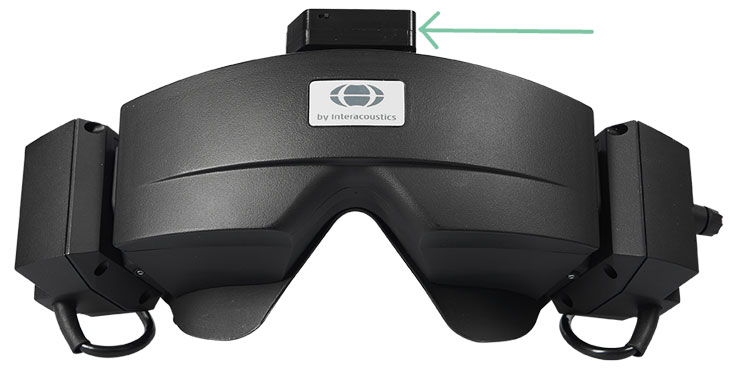Join the Interacoustics community and receive news about new products, events and much more
Get a-head of the game with VORTEQ™ Assessments
The measurement of eye movements is critical for accurate diagnosis and evaluation of treatment progression. However, the position and speed of the head can play a significant role in the diagnosis of benign paroxysmal positional vertigo (BPPV) and vestibular-ocular reflex (VOR) disorders.
Get a-head of the game with our VORTEQ™ inertial measurement unit (IMU) sensor. The IMU is a small sensor that tracks the position of the head and the speed of head movements. This small unit has big implications when it comes to accurate testing and final diagnosis.
As part of Interacoustics’ VORTEQ™ Assessments package, you can add it to your current videonystagmography (VNG) goggles.

Here are the top three benefits of adding the VORTEQ™ Assessments package to your clinical practice.
1. Measure head speed of the VOR with the head sensor
A head sensor allows for the measurement of head speed to quantify the function of the VOR. There are three main assessments of the VOR that provide this functional data to direct therapy decisions. Let’s take a closer look at these three assessments.
Dynamic Visual Acuity (DVA)
The first is the Dynamic Visual Acuity (DVA) test, which uses a standard head velocity and changing optotype size. DVA establishes the smallest size of optotype you can read at a constant head velocity.
DVA originates from the bedside test using the Snellen chart. Computerized DVA provides more specific data for which direction of the VOR is experiencing a deficit. With bedside testing, you can determine if the patient is having difficulty with horizontal versus vertical head movements. The computerized version allows the specificity to tell you if it is a leftward, rightward, upward, or downward VOR deficit.
This discrete data is helpful in focusing therapy efforts to best use you and your patient’s time.
Gaze Stabilization Test (GST)
The second test is the Gaze Stabilization Test (GST), which also assesses the function of the VOR for both vertical and horizontal head movements. However, GST utilizes a standard optotype size and a differing head speed. This test allows you to determine the exact velocity and direction at which the VOR breaks down, which can be critical information for starting therapy.
Learn why Katherine Beckwith, Au.D., uses GST in the video below.
Functional Vision Head Impulse Test (fvHIT™)
fvHIT is a functional assessment of the vestibulo-ocular reflex (VOR) in response to quick head impulses. This test is similar in technique to the Video Head Impulse Test (vHIT), where the patient receives randomized, quick head impulses in each of the canal directions (lateral, LARP, RALP).
However, in the fvHIT test, the patient responds with the direction of the optotype. Whereas the vHIT provides objective information on the VOR, the fvHIT provides functional information about how clearly the patient sees in response to quick head impulses. The fvHIT is performed across a broad range of accelerations.
2. Measure head position with the head sensor
Beyond measurement of head speed, a head sensor is useful for the measurement of head position in space. In many vestibular tests, we rely on the position of the head as a potential trigger of expected or unexpected eye movements.
For example, in Dix‑Hallpike and Lateral Head Roll testing, the position of the head is very important for accurate testing and diagnosis. A head sensor allows for exact and real-time 3D head modeling to provide feedback to you while testing and treating for BPPV.
Besides traditional BPPV tests, there are emerging tests that recognize the importance of head position in comparison to eye movements and position. The Ocular Counter Roll (OCR) test evaluates the function of the utricle by putting the head/body in a particular position while measuring eye movements. OCR testing is only accurate if properly monitoring head position during testing.
3. Measure torsional eye movements
The extra-ocular muscles allow for horizontal, vertical, and torsional eye movements. So why have we never regularly measured torsional eye movements? VNG equipment has not had the capability to do so, until now. And research is supporting the measurement of torsional eye movements in multiple assessments, such as the Advanced Dix-Hallpike and OCR tests, to aid in interpretation and diagnosis.
Interacoustics’ VisualEyes™ uses a torsional detection algorithm from Johns Hopkins University that uses structures from the iris (instead of the pupil) to track torsional eye movements. The standard is changing from only the measurement of horizontal and vertical eye movements to the addition of the measurement of torsional eye movements.
Small add on, large potential
In conclusion, VORTEQ™ Assessments is an easy add on with a small head sensor and large potential for improved diagnostics in your clinic. You can add it on to Interacoustics’ VisualEyes™ 505 and VisualEyes™ 525 and provides the following tests:
- Lateral Head Roll
- Gaze Stabilization
- Dynamic Visual Acuity
- Advanced Dix-Hallpike
- Functional Vision Head Impulse Test
These tests use a head sensor for accurate measurement of head position and head velocity. This, when paired with the ability to measure torsional eye movements, elevates your clinic’s diagnostic assessments.
Get a-head of the game and add the VORTEQ™ Assessments bundle.
For more information, contact your local Interacoustics sales office.
About the author
Dr. Liz Fuemmeler, Au.D., is a Clinical Product Manager with Interacoustics and Vestibular Program Director at Professional Hearing Center in Kansas City, MO.

Similar Topic
Stay up to date!
Subscribe to our newsletter and receive news on new products, seminars and much more.
By signing up, I accept to receive newsletter e-mails from Interacoustics. I can withdraw my consent at any time by using the ‘unsubscribe’-function included in each e-mail.
Click here and read our privacy notice, if you want to know more about how we treat and protect your personal data.
